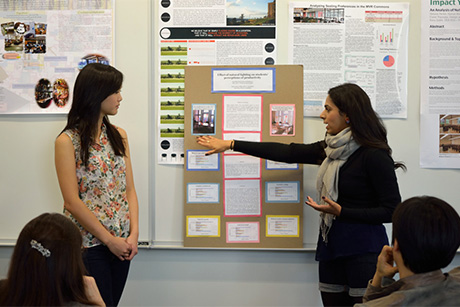New course blends health policy and facility design
By Sarah Cutler

In Policy Meets Design, a new course offered by the Department of Design and Environmental Analysis (DEA), Levi Schoenfeld ’15 and Dani Corona ’15 brainstorm ideas for a redesign of the pediatrics section of a health clinic in Peru. The pair has rethought the clinic’s workflow and layout to streamline traffic and minimize steps involved in seeing patients – small changes that can make a big difference.
The project fits the course’s larger aim: to show how evidence-based design principles can be applied in health care and other settings to boost efficiency and adapt to fast-changing policies and business and operational models.
“The class is based in reality – it’s very evidence-based and real-world,” Schoenfeld said.
Co-taught by Mark Furgeson and Michele Flanagin, executives at FreemanWhite and Kaiser Permanente, respectively, the course, created by DEA assistant professor Rana Zadeh in the College of Human Ecology, allows students to work with health care community partners to study patient and worker needs, analyze new policies and propose design solutions. Its community-based activities are funded in part by Cornell’s Engaged Learning + Research center and the Translational Research Institute on Pain in Later Life in the Bronfenbrenner Center for Translational Research.
“This class initiates a multidisciplinary dialogue on the pressing health care issues of our era,” Zadeh said.
The course, Zadeh said, tackles the “big questions” in health design: how to ensure quality, efficiency and safety for patients in light of changing policies and cost reductions in health care.
“We want to study how to design a facility that can be sustained in a very competitive future of health care,” she said. “Quality and safety will be high priorities, but health care dollars are precious, so the goal is to take costs down while boosting quality and efficiency.”
Students in the class engage in community fieldwork to examine how theories from environmental psychology and behavioral economics can help optimize design to produce sustainable health care facilities. In October, for instance, they visited a Hospicare facility to observe its physical environment, as well as staff, patient and family interactions.
Student design suggestions aim to improve the total well-being of patients and residents, including their spiritual, social, psychological and physical health, according to Zadeh.
“Design is the first point of contact for [patients],” Zadeh said. “If they have a restorative view of a garden or a bird feeder – if they’re comfortable and have control over their environment – that has a major impact on the experience they’ll have.”“As practitioners, we’re the boots on the ground. We have a lot of ideas about what would work, but we aren’t academics,” said Debra Traunstein, palliative care coordinator at Cayuga Medical Center, who hopes dialogue between students and practitioners will lead to improvements in patients’ environments. “It’s the same with those researching – they may not have the experience we do, so we can enlighten them with what the experience is like for patients,” she said.
The course, which includes graduate students from the Sloan Program in Health Administration and undergraduates from four Cornell colleges, holds wide-ranging discussions focused on new innovations, Zadeh said. For instance, she said, two students submitted a proposal to replace paper-based patient forms to a Knight News Challenge competition to fund breakthrough ideas in news and information.
“I hope students see the power of multidisciplinary dialogue,” Zadeh said. “Generating innovative solutions and effecting change is possible when different stakeholders and disciplines work together from different angles.”
Sarah Cutler ’16 is a student communications assistant for the College of Human Ecology.
Media Contact
Get Cornell news delivered right to your inbox.
Subscribe